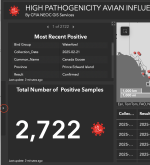Jeff Reardon
Well-known member
Steve Sanford's comment on the thread about Alaskan nest boxes caught my eye, and rather than divert that thread, I figured I'd start a new one.
What are folks around the country seeing for avian flu impacts on waterfowl? We had a pretty large mortality event on Canada geese and ducks. (Duck species not specified in media accounts I saw.
On social media I've been seeing regular accounts of bald eagles scavenging waterfowl carcasses--but of course that's normal in the winter.
The distribution so far seems heavily weighted to southern Maine and the coast, but that's also where waterfowl populations and people to trip over carcasses are concentrated this time of year.

 www.pressherald.com
www.pressherald.com
What are folks around the country seeing for avian flu impacts on waterfowl? We had a pretty large mortality event on Canada geese and ducks. (Duck species not specified in media accounts I saw.
On social media I've been seeing regular accounts of bald eagles scavenging waterfowl carcasses--but of course that's normal in the winter.
The distribution so far seems heavily weighted to southern Maine and the coast, but that's also where waterfowl populations and people to trip over carcasses are concentrated this time of year.

More than 20 birds found on Ogunquit Beach likely died of avian flu
State officials warn that the risk for animals is high and urge residents to take precautions to limit the spread of the virus.


